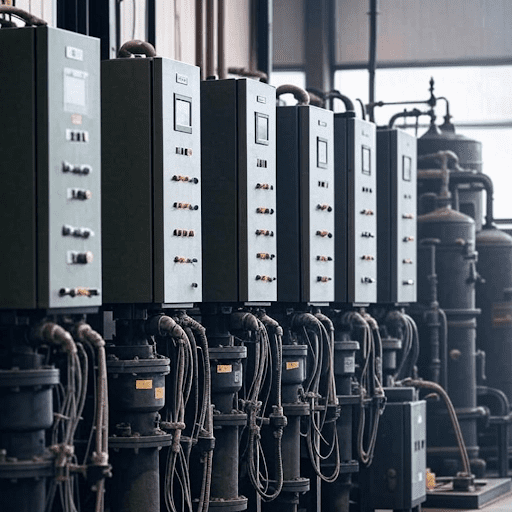In the contemporary industrial settings, having a continuous power supply is important to be efficient in terms of work, safety of the workplace, and efficiency. Any power interruption will result in an expensive downtime, risked safety, or valuable data loss. The battery discharger is one of the best tools that may be used in ensuring reliable power systems. These machines are safe to discharge the stored energy of batteries to test its performance, capacity and life. Battery dischargers are critical to sectors that require power consistency through monitoring battery health, avoidance of overcharging and extension of battery life.
Knowing about Battery Dischargers and their Significance
Battery dischargers are used to measure battery capacity, efficiency and condition because they release electrical energy in batteries in a safe, controlled, and controlled manner. The awareness of the precise position of the backup power systems in the manufacturing industry, energy production, transportation, and critical infrastructure is crucial to avoid operational disruptions and unplanned expenses.
Good battery dischargers enable the technicians to do regular maintenance, identify poor or failing cells and make sure the batteries are emergency-ready. The predictive maintenance method has the effect of minimizing sudden failures, improving the operational reliability, and ensuring the safety in the industrial processes.
Varieties of Battery Dischargers
There are a number of types of battery dischargers which are dependent on industrial use:
Portable Dischargers: Portable, On-Site Battery Test.
Rack-Mounted Dischargers: The dischargers are used in large scale, where several batteries are being monitored at a time.
Programmable Dischargers: Can be programmed with custom discharge cycles and cut-off settings which are best suited in precision testing.
Advanced Data Logging Dischargers: Dischargers with advanced data logging and analytics provide detailed analytics and discharge curves to monitor the battery on a long-term basis.
All the types provide customized solutions to enhance battery management, flexibility, and accuracy.
The Major Advantages of Battery Dischargers
Long Battery Life: Calibrated discharging helps in avoiding excessive use and deep-cycling which prolongs battery life.
Stable Operation: Batteries offer a stable supply of power in the event of severe power outage like backup generators in hospitals, data centres and telecom towers.
Preventive Maintenance: This is used to tell the weak cells at an early stage so that they can be fixed or replaced.
Data Recording and Analytics: Provides insight into specific trends, discharge curves and battery health.
Safety Assurance: Reduces the likelihood of the equipment overheating, leaking or unsafe malfunctioning when testing.
Industrial Applications.
Battery dischargers are required in various industries:
Power Utilities: Have back-up batteries on substations and stand-by generators.
Telecommunications: Make sure that the network activities and data transfer occur without problems.
Solar battery: Check energy storage batteries in solar farms, wind farms and hybrid systems.
Industrial Automation: Ensuring the stable functioning of machines, robotics, and other important control systems.
Healthcare & Emergency Services: Have backup systems in hospitals operational to save life in case of outages.
The way Amperis contributes to efficient battery management

Amperis is a manufacturer of quality battery dischargers which are also reliable, accurate, and user friendly. Their devices have a user-friendly interface, accurate measurements, and powerful safety measures. Training of technicians is carried out to ensure that they are fully equipped to use these devices with efficiency in the maintenance and poise of operations.
Installation of Amperis battery dischargers in predictive maintenance programs minimises downtimes, maximises the performance of the batteries and minimises maintenance expenses. Organizations can check the health of the battery in real time and make informed decisions related to changing batteries or repairing them, as well as guaranteeing continuous power supply.
It is possible to predict future trends in battery maintenance
With the continuum of resources directed towards renewable energy, electric vehicles, and automation in the industries, battery dischargers are getting more important. Emerging trends include:
IoT-enabled Smart Dischargers: Remote monitoring and predictive analytics at multiple locations.
Automated Battery Health Systems: AI and machine learning enable early warning of battery problems and recommendations based on predictive maintenance.
Eco-Friendly Testing: The devices that reduce energy wastage without compromising the process of generating accurate results.
These trends increase reliability, minimize maintenance expenses and increase battery life.
Conclusion
The maintenance aspect is only part of the story, investing in advanced battery dischargers is also a strategic move that leads to reliability and safety of operations as well as long-term cost effectiveness. Battery dischargers can assist the industrial systems to be strong and operational by allowing accurate testing and early identification of weak batteries and effective preventive maintenance.
The selection of Amperis will ensure the quality of equipment, high-qualified technical support, and extensive battery management solutions. Through the integration of such devices, organizations are able to protect critical infrastructure, better battery usage, minimize downtime and gain operational excellence over time.
Industries that are concerned about continuous power, safety, and efficiency are the ones that require battery dischargers. They enable companies to remain proactive, strong, and geared up to meet the energy requirements of the current and the future.





























